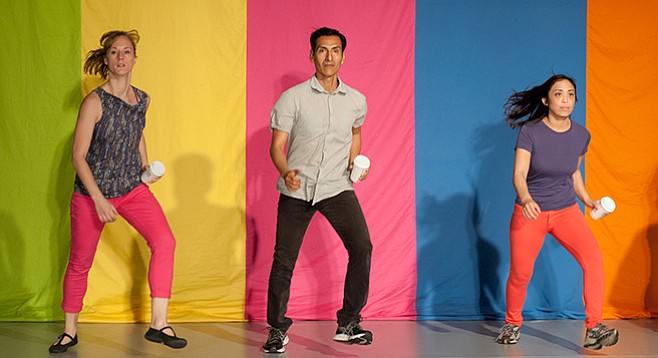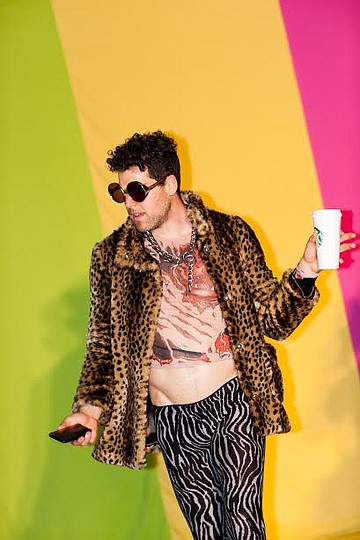 Facebook
Facebook
 X
X
 Instagram
Instagram
 TikTok
TikTok
 Youtube
Youtube

Open stage. Rear wall: five vertical stripes — green, yellow, red, blue, orange — an off-beat rainbow. Six performers walk eight steps forward, turn, and walk eight steps back on invisible aisles for 45 minutes.
But they don’t just walk. They strut, mosey, skip, slink, or march (even against the dominant east/west grain), Each with a different attitude and relation to the audience. Sometimes indifferent, at others fired up.
They change costumes behind the stripes. A lot: jeans and plaid cotton shirts appropriate for a Texas two-step; different uniform-like outfits for work or war, casual apparel, up-market chic.
And at one point they are naked. But not in a sexually titillating way; they just aren’t wearing clothes.
They often carry a container: Starbucks cups, beer cans in brown paper bags; long plastic glasses with green straws. There are five stripes on the wall and six performers, like musical chairs, so one must exit, stage right, to make room for the next. As people leave, they toss their container in a trash bin. A full bin has a layered look, given the different kinds of cups, and a custodian cleans it out.

Mark Haim’s fascinating dance piece is so precise that, when the custodian collects the trash, Tim McGraw sings “I’m taking out the trash and I’m sweeping my floors” (from “I Like It, I Love It”).
The music’s mostly country inflections: Hank Williams’ “Cold, Cold Heart,” Ronnie Milsap’s “Any Day Now” (though one would have much preferred Chuck Jackson’s epic rendition); Billy Ray Cyrus’ “Achy Breaky Heart.”
Haim’s title comes from Woody Guthrie’s iconic folk song. The piece begins with Patsy Cline’s equally famous, “Walking After Midnight” and unfolds with successive waves of diversity in the U.S., held together, apparently, by the liquids we imbibe in common.
In an interview Haim said This Land is about “contemporary issues, including body image, consumerism, and environmental irresponsibility.” Those are there, certainly, but it’s the subtle changes that catch the eye — and how fads and styles arrive, flourish, and end up in the trash.
Plus conceptions of self: Is each person an individual, or merely a follower of fashion just marching with the ducks?
The form also fascinates. It is, at once, redundant as all get out and yet new, as various rinses parade in front of the stripes. Like the physical patterns, the score evolves but never ceases. The combination of sounds, changes of color, and movement become hypnotic. The laughter of surprise often breaks the spell.
The evening, presented by youTurn 2015, begins with legendary bluesman Tomcat Courtney. He plays guitar and harmonica and lays the foundation for the show, singing, among others, Jimmy Reed’s “Baby What You Want Me to Do,” Tony Joe White’s “Poke Salad Annie,” and BB King’s immortal “Every Day I Have the Blues” — i.e. “When you see me worried, baby/You know you’re gonna hate the news.”


Open stage. Rear wall: five vertical stripes — green, yellow, red, blue, orange — an off-beat rainbow. Six performers walk eight steps forward, turn, and walk eight steps back on invisible aisles for 45 minutes.
But they don’t just walk. They strut, mosey, skip, slink, or march (even against the dominant east/west grain), Each with a different attitude and relation to the audience. Sometimes indifferent, at others fired up.
They change costumes behind the stripes. A lot: jeans and plaid cotton shirts appropriate for a Texas two-step; different uniform-like outfits for work or war, casual apparel, up-market chic.
And at one point they are naked. But not in a sexually titillating way; they just aren’t wearing clothes.
They often carry a container: Starbucks cups, beer cans in brown paper bags; long plastic glasses with green straws. There are five stripes on the wall and six performers, like musical chairs, so one must exit, stage right, to make room for the next. As people leave, they toss their container in a trash bin. A full bin has a layered look, given the different kinds of cups, and a custodian cleans it out.

Mark Haim’s fascinating dance piece is so precise that, when the custodian collects the trash, Tim McGraw sings “I’m taking out the trash and I’m sweeping my floors” (from “I Like It, I Love It”).
The music’s mostly country inflections: Hank Williams’ “Cold, Cold Heart,” Ronnie Milsap’s “Any Day Now” (though one would have much preferred Chuck Jackson’s epic rendition); Billy Ray Cyrus’ “Achy Breaky Heart.”
Haim’s title comes from Woody Guthrie’s iconic folk song. The piece begins with Patsy Cline’s equally famous, “Walking After Midnight” and unfolds with successive waves of diversity in the U.S., held together, apparently, by the liquids we imbibe in common.
In an interview Haim said This Land is about “contemporary issues, including body image, consumerism, and environmental irresponsibility.” Those are there, certainly, but it’s the subtle changes that catch the eye — and how fads and styles arrive, flourish, and end up in the trash.
Plus conceptions of self: Is each person an individual, or merely a follower of fashion just marching with the ducks?
The form also fascinates. It is, at once, redundant as all get out and yet new, as various rinses parade in front of the stripes. Like the physical patterns, the score evolves but never ceases. The combination of sounds, changes of color, and movement become hypnotic. The laughter of surprise often breaks the spell.
The evening, presented by youTurn 2015, begins with legendary bluesman Tomcat Courtney. He plays guitar and harmonica and lays the foundation for the show, singing, among others, Jimmy Reed’s “Baby What You Want Me to Do,” Tony Joe White’s “Poke Salad Annie,” and BB King’s immortal “Every Day I Have the Blues” — i.e. “When you see me worried, baby/You know you’re gonna hate the news.”
Comments